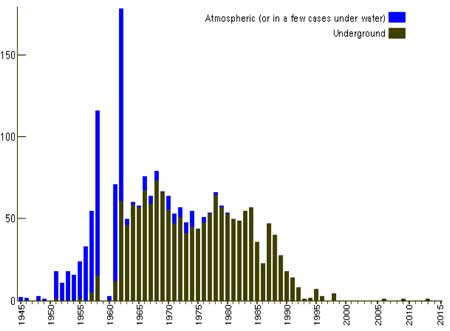Atomic bomb
 scroll scroll 
Nuclear weapon using the energy released during the
fission of U-235 or Pu-239. The explosive force of a nuclear weapon
is indicated in kilotonnes (kt) or megatonnes (Mt) of TNT equivalents
(TNT (trinitrotoluol) is a chemical explosive). The bombs dropped on
Hiroshima (U-235 bomb) and Nagasaki (Pu-239 bomb) had an explosive energy
equal to 13 and 22 kt TNT. In each case about 1 kg fission material
was fissioned in one millionth of a second. A minimum mass of fission
material is required for a nuclear blasting charge, e.g. 52 kg of U-235.
The highly developed weapon technology in the nuclear weapon countries
partly enables lower values, e.g. 15 kg and less for metallic U-235.
An ignition device is also required to shoot these fission materials
together to a critical configuration within
a very short period so as to initiate the chain reaction. Experts quote
a velocity of some kilometres per second for weapon plutonium and a
multiple of this impact velocity is necessary for reactor plutonium
with its high share of other plutonium isotopes. See 'hydrogen
bomb'.
Type of fission
material |
|
as a metal |
as an oxide |
Weapon plutonium |
10 |
30 |
Reactor plutonium |
>13 |
40
|
93% enriched U-235 |
52 |
100 |
3% enriched U-235 (LWR-fuel) |
not possible |
not possible |
U-233 |
16 |
40 |
Estimated minimum quantity of fission
material for nuclear blasting charges
According to UNSCEAR 504 atmospheric explosion (plus 39
safety tests) and 1879 underground explosions were carried out till
mid of Februar 2013.

Nuclear explosions by year

Nuclear explosions by country
back
|
|

11 - 15 March 2018
Munich, Germany

30 September - 04 October 2018
Prague, Czech Republic |